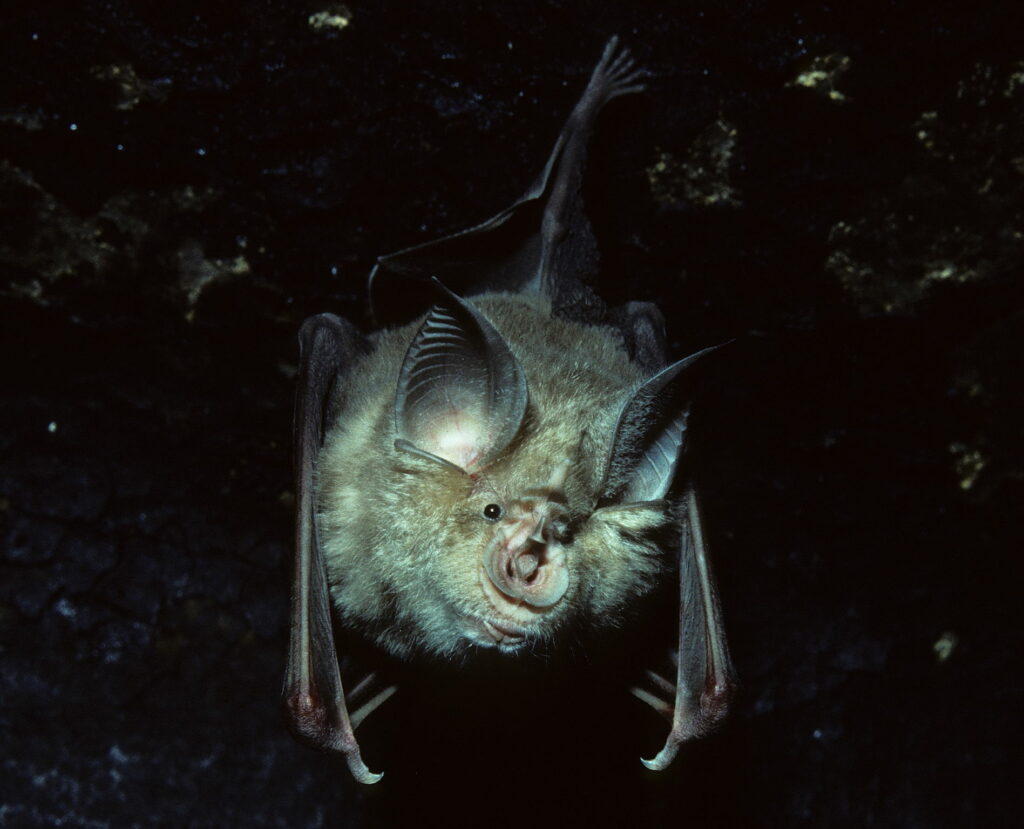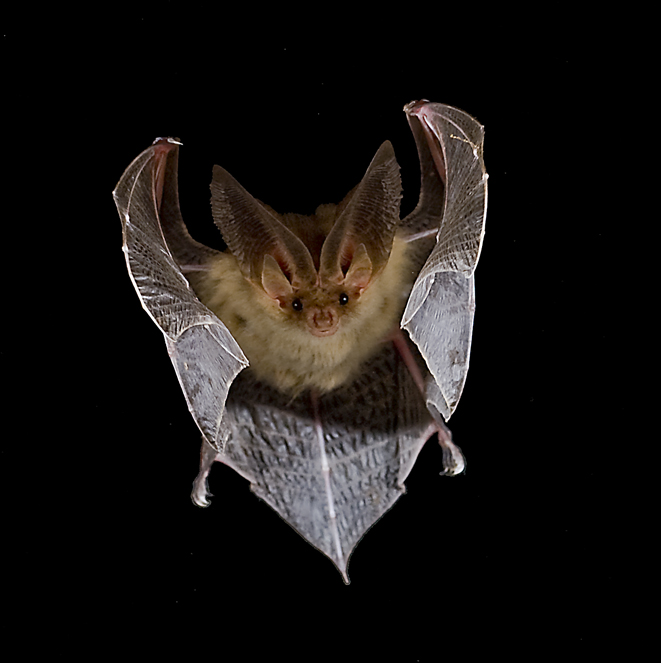Bats, the other victims of SARS-CoV-2

Lesser horseshoe bat (Rhinolophus hipposideros) photographed in Huelva.Javier Juste Ballesta, author provided
Javier Juste Ballesta, Estación Biológica de Doñana (EBD-CSIC); Antonio Figueras Huerta, Instituto de Investigaciones Marinas (IIM-CSIC) y Juan E. Echevarría Mayo, Instituto de Salud Carlos III
Ever since its inception, the COVID-19 pandemic has been associated with bats. Both the World Health Organisation (WHO) and the Spanish Ministry of Health, Consumption and Welfare affirm that the natural reservoir of the SARS-CoV-2 coronavirus is bats. Today everyone accepts this as a proven fact. All this despite the fact that there is no scientific evidence directly linking SARS-CoV-2 with any bat, as recognised by the World Organisation for Animal Health (OIE) and despite explanatory notes from the Spanish Society Virology (SEV), the Spanish Association for the Conservation and Research of Bats (SECEMU) and International organisations such as Bat-Life Europe or EUROBATS.
The origin of this mess lies in the confusion between the epidemiological origin of the pandemic and the evolutionary origin of the SARS-CoV-2 coronavirus. To study both we use a similar tool based on comparing genomes (or sequences). The more similar the genetic sequences are the closer the viruses will be in their evolution. Epidemiology counts on tools such as epidemiological surveys or field research.
What is the origin of the pandemic?
The answer is that this is still unknown. We still have no idea and, of course, nothing in epidemiological studies points towards a bat being the origin of the pandemic or even the natural reservoir of the causative virus. What is certain is that the SARS-CoV-2 came from an animal (zoonosis). Therefore, the coronavirus has to be in some host but so far neither this the SARS-CoV-2, nor any other sufficiently similar virus, has been found in any other animal (including bats of course). Using different methods, it has been estimated that SARS-CoV-2 emerged in late November or early December 2019 and possibly occurred in the Hubei province in China.
What is the evolutionary origin of the SARS-CoV-2 coronavirus?
This question also remains unanswered, but we find more clues which now involve bats. In fact, the result of the genetic comparisons indicates that the coronavirus most similar to the SARS-CoV-2 is the RaTG13 virus isolated from the Horseshoe Bat (Rhinolophus affinis).
SARS-CoV-2 and RaTG13 share 96.2% of their genomes, roughly the same level of genetic similarity between humans and chimpanzees. However, even though they are very similar, the genomes of these two coronaviruses show over 1,200 nucleotide difference. The SARS-CoV-2 and RaTG13 coronaviruses have been calculated to have diverged some 50 to 70 years ago!
These differences make it unlikely that the origin of the pandemic is in the bat coronavirus. In the comparison, it was also observed that the differences accumulate in two specific and highly variable areas within the gene that determines the protein responsible for cell binding (S). Both are extremely important for the transmission and infection of SARS-CoV-2.
The first area is related to the binding to the host cell’s membrane receptor, known as a Receptor Binding Domain (RBD) – the entry key. The second is an area that increases the infectious potential of the coronavirus where SARS-CoV-2 has a particular four-amino-acid insertion.
This sequence of the SARS-CoV-2 spike gene resembles that of a new Sarbecovirus found in pangolins, which caused them to be related to the origin of the coronavirus, but the study of the rest of the genomes has ruled out that idea. None of the bat Sarbecoviruses studied presented this insertion but it was very recently found in virus hosted by another horseshoe bat. In summary, the data currently available DO NOT support the hypothesis most frequently broadcast by the media regarding the coronavirus’ origin in bats with the pangolin as an intermediary host.

Greater horseshoe bat (Rhinolophus ferrumequinum) photographed in Aragón.
Domingo Trujillo, Author provided
Coronaviruses and bats
Coronaviruses are a type of RNA virus characterised by their ability to recombine and easily jump from one host to another with a certain frequency. This implies plasticity to adapt to new conditions and replicate in the cells of a new host.
Although present in a large number of hosts such as pigs, mice, birds, cats, civets and camels, they have an undoubted affinity for bats. In fact, many species of bats are hosts to a great diversity of viruses included within the alpha and betacoronavirus genera.
They are found on bats of different continents and the diversity of coronaviruses is correlated with that of bats. Comparative phylogenies suggest that bats and viruses have co-evolved for a long time. SARS-like viruses (Sarbecoviruses) are characteristically present in the horseshoe and leaf-nosed bat families that extend from Asia and the Palaearctic region, to Africa, but without reaching America where the Sarbecoviruses have only arrived now after the introduction of SARS-CoV-2 by humans.
Two recent zoonoses are related to bat coronaviruses. The first is Severe Acute Respiratory Syndrome (SARS) that was declared in 2003 in China and caused by a then-unknown coronavirus (SARS-CoV) causing over 8,000 cases and almost 800 deaths in several countries.
Civets were identified as the possible source of the epidemic, since SARS-CoV was detected in civets sold at the market in the city of Guandong, where the zoonosis originated. However, the virus was never found in wild civets, so it is considered that these animals were not its natural reservoir, but an intermediate host.
The reservoir was searched for in other species, and it was discovered that horseshoe bats presented a great diversity of Sarbecoviruses similar to SARS-CoV. As a result, it was hypothesized (as it remains today) that the SARS emergency occurred due to a SARS-CoV jumping from a horseshoe bat to civets and from these to humans.
In 2012, another outbreak called Middle East Respiratory Syndrome (MERS) was declared in Saudi Arabia. The epidemic is still active and to date 2,494 cases and 854 deaths have been declared, the majority of those affected are in the Persian Gulf, but also in other countries.
In this case, MERS was found to be caused by the Merbecovirus MERS-CoV and transmitted by dromedaries. Unlike SARS, it appears that the jump to humans has not been a single event, but that it occurs repeatedly and the spill-over is associated with direct contact with dromedaries in markets and during domestic uses. Their ability to establish effective chains of transmission between humans is, fortunately, limited.
In this case related, although very different Merbecoviruses, have been found in very different species of bats, mainly within the family Vespertilionidae and in distant regions, so the connection with the intermediate host is not clear.

Brown long-eared bat (Plecotus auritus) photographed in País Vasco.
Joserra Aihartza, Author provided
Do bats carry more viruses than others mammals?
This is not an easy question to answer, since it would require large unbiased databases with similar sample sizes. An added problem is that many groups of mammals (not to mention vertebrates) are hardly studied, such as the Order Pilosa (which includes sloths) among the Eutheria (group to which we belong) or all the Metatheria (kangaroos and other marsupials). These studies can hold huge surprises as recently happened when reviewing pangolins (Order Pholiota) in relation to coronaviruses.
If the bats (Order Chiroptera) are compared with a group that has received similar efforts, such as the Order Carnivora, the result is that there are no differences in the number of viruses.
If we compare bats with the most diverse group (rodents), there are no great differences either, and compared to 2.7 viruses/species in bats, rodents present an average of 2.48.
Analysing over 750 viruses described for 13 orders of mammals, bats do not stand out significantly here either. In fact, a recent study indicates that zoonoses are equally likely from any group of mammals including bats and basically depend on the diversity of viruses in each group, which in turn depends on the species richness of each specific group.
Therefore, the clear conclusion is that bats are no ‘worse’ than the rest of mammals. They were not prior to, and will not be after COVID-19.
Do bats in my house have COVID-19? Can the bats in my house infect me with COVID-19?
As we have seen, the virus that causes COVID-19 has not been isolated from any of the 1,400 species of bats in the world. Therefore, they cannot transmit to us what they do not have.
The only known pathogenic viruses that bats can transmit directly to us in our latitudes (and only some species) are some lissaviruses that can cause rabies.
Finally, it is important to remember that COVID-19 transmission is from person to person. It is in this way that the disease continues to spread worldwide.
Why bats are accused and the consequences of doing so
The evolutionary proximity of SARS-CoV-2 to a bat host virus (RaTG13) and the existence of evolutionary relationships with viruses that caused previous epidemics (SARS, MERS, Ebola, etc.) have caused bats to be pointed as being the reservoirs of the new virus and the cause of the COVID-19 pandemic. As we have seen so far, without any scientific basis.
Admittedly, bats are generally not a friendly group of animals for most of society. Partly due to the multitude of topics and ignorance, that surrounds them. Neither does their rare physical appearance, considered grotesque at times, help nor does their nocturnal habits, when in fact it is our diurnal character, the exceptional one among mammals. Finally, the permanent association with vampires that bats evoke, although perfectly fair (and almost inevitable), does not help their image much either.
The combination of these accusations with negative social perception has triggered the perfect storm and thousands of bats are being stupidly slaughtered today in Peru, Indonesia, China and other countries in the name of fighting the pandemic. In this environment, it does not produce resentment for scientists to kill 1,066 bats in Gabon these days to obtain information that would have also been obtained by taking samples with swabs.
The consequences of this trend can be catastrophic. Despite their enormous evolutionary success on all continents with over 1,400 species. Bats are very sensitive to environmental disturbances. So far, 5 species have become extinct in historical times (all on islands) by human action, 15% of species are threatened, another 18% probably are too, but there is no data to include them in any of the current categories of the IUCN and only a fifth of the species are estimated to maintain stable populations.
The negative, as well as immoral and unfair, attitude toward bats is counterproductive: their enormous services to the ecosystem and to our species, as pollinators (of banana or papayas trees, p.e.), seed dispersers and controllers of populations of insects and pests are far from negligible. Millions of dollars and tons of pesticides would be needed to replace their role in controlling pests just on corn or rice crops.
Furthermore, centuries of co-evolution with coronaviruses could be used to design therapeutic strategies against pandemics such as the current one.
Still, it will take many years of investment in education and outreach to restore bats’ image after this pandemic.
Javier Juste Ballesta, IUCN Bat Specialist Group. Doñana Biological Station (CSIC);
Antonio Figueras Huerta, Research professor at the Higher Council for Scientific Research, Institute of Marine Research (CSIC);
Juan E. Echevarría Mayo, Scientific researcher-head of unit. Virus Isolation and Detection Unit. Laboratory of Reference and Research in Immunopreventable Viral Diseases. National Center for Microbiology. Carlos III Health Institute.
This article was originally published in The Conversation. Read the original.

